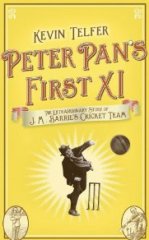Peter Pan’s First XI
David Taylor |Published: 2010
Pages: 344
Author: Telfer, Kevin
Publisher: Sceptre
Rating: 3 stars

The Scottish playwright and author James Matthew Barrie was of course, best known for the story which gives this book its title, but he was also hugely enthusiastic about cricket – both watching and playing. Although a player of miniscule ability he knew others who could perform on the cricket field and between the late 1880s and shortly before the outbreak of the First World War, assembled teams of fellow writers, actors and artists reinforced by the occasional genuinely good cricketer. He gave them the name ‘the Allahakbarries’ which he claimed meant ‘God help us’ although that was not, of course, strictly correct.
With the side having no ground of its own, the first few matches were played at the village of Shere in Surrey. The first was lost by a wide margin, some of the team seemingly having little or no familiarity with the game, but after a few attempts Barrie’s side registered a win or two and moved on to other opponents. Of Barrie himself it appears that he was a left arm slow bowler of modest talents, and an utterly hopeless tailender. He it was who made the self-deprecating remark that if he didn’t like the ball he’d bowled, he could run after it and fetch it back.
Among those who featured in the team were Arthur Conan Doyle, a pretty useful all-rounder good enough to play ten first-class matches for MCC, EW Hornung, Jerome K Jerome, PG Wodehouse and AA Milne. None of these played in every match and some never met on the field of play: Jerome played only in the first match, while Milne, 21 years Barrie’s junior, was one of the last recruits. Curiously, all of these, and JM Barrie of course, was best known for just one book or character. In Barrie’s case it was Peter Pan, which started life as a play, rejected in fact by an alarmed theatre manager, but which later made him a fortune. The Admirable Crichton, later made into a successful film, is perhaps his next best-known work.
Towards the end of the book we have the outbreak of war, when naturally the narrative takes on a much more sombre tone. Although most of the team were too old to be called up, their sons were soon experiencing the horrors of war. A commission was no lifesaver and a young officer who perhaps only a couple of summers earlier had been leading the XI at Charterhouse or Winchester was now expected to lead his platoon over the top. Barrie, married but childless, had long been friendly with the Llewellyn Davies family and their five sons, the eldest of whom was killed in 1915. With the death by drowning of the second son in 1921, and the demise of many of his old team-mates, Barrie’s final years were often marked by sadness.
While much of the book describes light-hearted games of little consequence played between people who didn’t seem to care too much about the result as long as they had a good time, not everyone in Britain in the late Victorian era was living such a carefree and idyllic lifestyle. Telfer makes the point that “it was becoming clear to more and more people that the decadence of the upper classes could only be afforded because of the industry of the workers” – something that the Great War would eventually help to change.
It’s hard to know what a bookseller might do with this title – it’s neither a biography of Barrie, nor a book about cricket – although I suppose it comes close to the former. As such it may be of fairly limited interest to cricket fans. But it’s well written and does a good job of evoking the period in question, which overlaps very much with what many call the ‘Golden Age’ of cricket.






Leave a comment